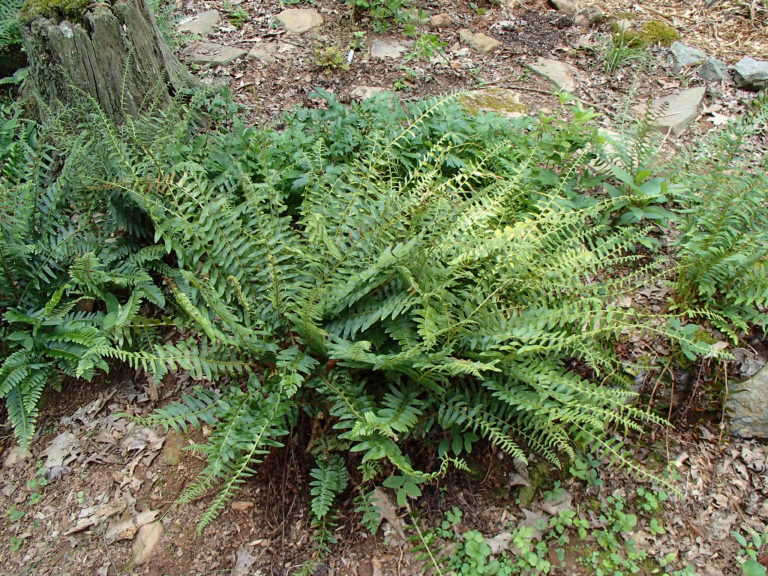Common in forested stream bottoms and damp slopes and ravines across Eastern North America, Christmas fern is the workhorse fern for gardens and naturalized areas in the mid-Atlantic region. It is a sturdy, attractive, medium sized (2 foot) fern which is evergreen (though the fronds fall flat on the ground in the winter) and tolerant of both very moist and somewhat dry conditions. It will thrive in humusy, well drained soils from partly sunny to full shade (bright) and will tolerate even more sunshine if sufficient moisture is available. In the spring new silvery, scaled fiddleheads emerge from the center of the flattened winter mat and slowly grow into upright, leathery, lance shaped, pinnately compound leaves. In some circles, fiddleheads are eagerly collected and cooked in the spring, but Christmas fern fiddleheads, while technically edible, do not feature largely in this tradition. Christmas fern is easily identified by the presence of a notch at the base of each leaflet (pinna), as it resembles the shape of a Christmas stocking.
NURSERY HOURS
Wednesday: 10-4 Thursday: 10-6 Friday-Saturday: 10-4 Sunday: 12-4
Polystichum acrostichoides

Key Info
Scientific Name: Polystichum acrostichoides (Michx.) Schott var. acrostichoides
Common Names: Christmas fern
Family Names: Dryopteridaceae (Wood Fern Family)
Plant Type: Fern
Leaf Retention: Evergreen
Special Characteristics: Attracts butterflies, Ornamental foliage, Rhizomatous, Reported to be deer resistant., Evergreen
Additional Info
Habit: The fronds are attached to a relatively short stalk that is brown at its soil base and green toward its apex. A central, perennial root supports the stalk that then supports the arching clump of tall fronds. The sterile fronds are shorter and less well supported than the spore-producing fertile fronds. The sterile fronds form an encircling, arching border around the central mass of taller, more erectly held fertile fronds. It is the fertile fronds which remain green throughout the year. There are also rhizomes from which new plants can arise vegetatively (Penn State New Kensington).
Height: 1'-2'
Spread: 1'-2'
Soil Conditions: Moist, acid or circumneutral pH, humus-rich soils: Sandy, sandy loam, medium loam. Best in rocky or sandy soils. see "Downside".
Leaves: Lance-shaped, dark-colored, leathery, pinnately compound fronds. Not all fronds are fertile (see "Habit"). Each fertile frond is composed of 20-40 leaflets, with the sori forming only on the upper third to half of the leaflets. These fertile leaflets are noticeably shorter than the non-sori bearing leaflets, giving the impression of a sudden narrowing of the entire fertile frond toward the top.
Flowers (or reproductive structures: The sori (reproductive structures) appear on the underside of the outermost third to half of the leaflets of the fertile fronds.
Fruit: spores
Natural Distribution: shaded slopes, ravines, stream banks
USDA Hardiness Zone: 3 to 9
USDA Wetland Indicator Status in NC: FACU
Wildlife Connections: DEER RESISTANT: Christmas fern populations are increasing in our forests due to the removal of competing but more palatable understory species through browsing by our rapidly expanding deer population. This change in the forest under-story habitat structure has had wide-spread and deleterious impacts on the mid-canopy birds, whereas other bird species (like the wild turkey, for example) that use the concealing fern masses for their nesting sites have increased in density in these "fern park" forests (Penn State New Kensington) .
Propagation: Multiplied by division or spores.
